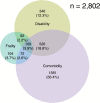Prevalence and Correlates of Frailty Among Community-Dwelling Chinese Older Adults: The China Health and Retirement Longitudinal Study
- PMID: 28525586
- PMCID: PMC5861883
- DOI: 10.1093/gerona/glx098
Prevalence and Correlates of Frailty Among Community-Dwelling Chinese Older Adults: The China Health and Retirement Longitudinal Study
Abstract
Background: Frailty is an age-related clinical syndrome of decreased resilience to stressors and is associated with numerous adverse outcomes. Although there is preponderance of literature on frailty in developed countries, limited investigations have been conducted in less developed regions including China-a country that has the world's largest aging population. We examined frailty prevalence in China by sociodemographics and geographic region, and investigated correlates of frailty.
Methods: Participants were 5,301 adults aged ≥60 years from the China Health and Retirement Longitudinal Study. Frailty was identified by the validated physical frailty phenotype (PFP) scale. We estimated frailty prevalence in the overall sample and by sociodemographics. We identified age-adjusted frailty prevalence by geographical region. Bivariate associations of frailty with health and function measures were evaluated by chi-squared test and analysis of variance.
Results: We found 7.0% of adults aged 60 years or older were frail. Frailty is more prevalent at advanced ages, among women, and persons with low education. Age-adjusted frailty prevalence ranged from 3.3% in the Southeast and the Northeast to 9.1% in the Northwest, and was more than 1.5 times higher in rural versus urban areas. Frail versus nonfrail persons had higher prevalence of comorbidities, falls, disability, and functional limitation.
Conclusions: We demonstrated the utility of the PFP scale in identifying frail Chinese elders, and found substantial sociodemographic and regional disparities in frailty prevalence. The PFP scale may be incorporated into clinical practice in China to identify the most vulnerable elders to reduce morbidity, prevent disability, and enable more efficient use of health care resources.
Keywords: Aging; China; Disparities; Frailty.
© The Author 2017. Published by Oxford University Press on behalf of The Gerontological Society of America. All rights reserved. For permissions, please e-mail: journals.permissions@oup.com.
Figures


References
-
- Ensrud KE, Ewing SK, Taylor BC et al. . Comparison of 2 frailty indexes for prediction of falls, disability, fractures, and death in older women. Arch Intern Med. 2008;168:382–389. doi:10.1001/archinternmed.2007.113 - PubMed
-
- Fried LP, Tangen CM, Walston J et al. ; Cardiovascular Health Study Collaborative Research Group. Frailty in older adults: evidence for a phenotype. J Gerontol A Biol Sci Med Sci. 2001;56:M146–M156. - PubMed
-
- Collard RM, Boter H, Schoevers RA, Oude Voshaar RC. Prevalence of frailty in community-dwelling older persons: a systematic review. J Am Geriatr Soc. 2012;60:1487–1492. doi:10.1111/j.1532-5415.2012.04054.x - PubMed
Publication types
MeSH terms
Grants and funding
LinkOut - more resources
Full Text Sources
Other Literature Sources
Molecular Biology Databases

